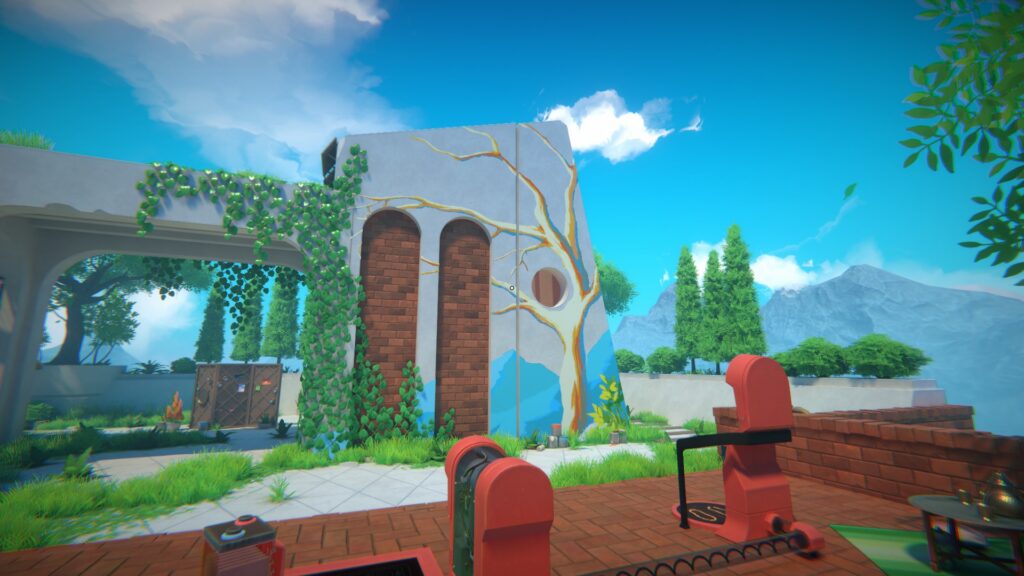So many puzzle games have tried to mess with the player’s sense of perspective that it’s rare that a game like Viewfinder manages to do something new. Portal and its sequel Portal 2 of course were masters of this technique, owing to the teleportation portals which allowed you to make impossible journeys across levels which broke many rules of Newtonian physics. Games like Superliminal deliberately played with the artificiality of video games to allow objects to change shape depending on how you look at them, or become physical elements after looking like background scenery. Viewfinder merges this idea with the concept of digital photography, allowing you to literally enter photographs, paintings and pictures you find in the world.
Viewfinder’s impressive gimmick and most satisfying trick never gets old. While navigating around some relaxing, almost Grecian environments, you find an old black and white photograph of an arch. Picking it up, you can then “place” the arch into the environment; the entire contents of the photo becomes real and interactable, overwriting anything behind it, allowing you to walk through the arch and explore the interior of the photo.

This concept is re-used again and again in increasingly imaginative ways. An early example is a gap between two islands, and you have a photograph of a bridge. You need to align yourself and the photo in order to place it in the correct location to project the bridge into the world, so you can get across. This is something you really need to see in motion to properly appreciate, as screenshots don’t really do justice to how satisfying it feels.
Viewfinder is very good at slowly ramping up the complexity, keeping things simple for the most part while gradually introducing new mechanics. There is a rewind system which allows you to undo anything you do in a level, including placing photographs in case you accidentally messed up. You can also change the orientation of the photographs, sometimes placing them on an angle in order to create a ramp, or flipping upside down so a ceiling becomes a walkway.

Later on, you gain access to a Polaroid camera where you can then take your own pictures of the world, allowing you freedom to select your own photographs which you can then place into the environment, mostly to be able to reach the teleporter to the next level. This could easily be overwhelming but you’re often restricted to only taking one or two pictures at a time, meaning you can’t overload yourself with options or erase half the map in one go (although you easily can also do that, should you choose).
Viewfinder does actually have a story and characters; the game is set within a computerised virtual environment somewhere in our soon-to-be-accurate ecological collapse of a near-future, where most of Earth is a burning hellscape. The virtual environment technology is apparently considered antiquated by the characters, but it might hold the key to solving climate change in the present. The voice acting is fairly good but I never felt very invested in the characters except for AI cat companion Cait, who is extremely cute (and whom you can pet). There are some audio logs left by the old environment designers going over their interpersonal relationships, but unfortunately they’re not very engaging to listen to.

Visually there is a predominantly European aesthetic to a lot of the environments which absolutely takes inspiration from Myst and The Witness with its whitewashed walls and verdant plant-life. It gives the game a really relaxing and pleasant atmosphere, it being lovely just to sit and enjoy the surroundings sometimes (a nice touch being you can actually sit down on most chairs). Some of the most fun the game has is when it experiments with other styles though, like when stepping inside a watercolour painting or a children’s picture book. Likewise the relaxing soundtrack helps to keep things nicely laid back.
Viewfinder might not be a particularly long experience, but I never stopped loving its unique photographic magic trick. The first time it happened, I literally said out loud “Wow” and stopped for ages to admire it, thinking there must be some kind of way that it was faked. But Viewfinder absolutely pulls off this trick with aplomb, allowing this unique bisection of 2D photography to be projected into a 3D world, creating a puzzle game which isn’t particularly challenging, but is always entertaining. This being the debut game from Sad Owl Studios, I am extremely excited to see what else they can do with this mechanic in future.





